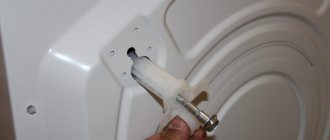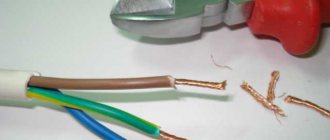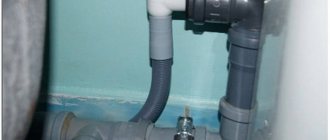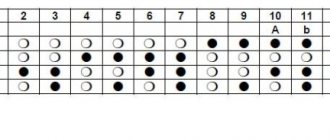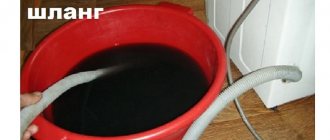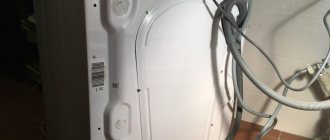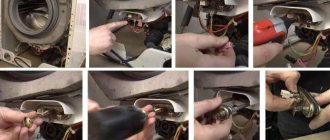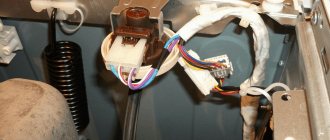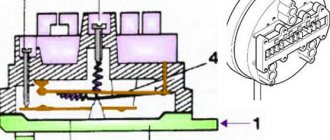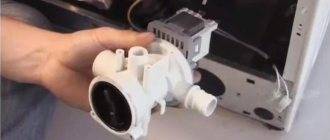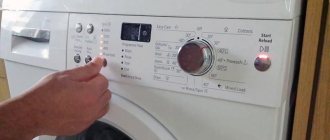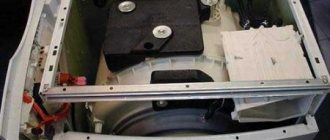The inlet hose is the product on which your peace of mind and safety of repairs in the apartment of the neighbors below depend. The fact is that the inlet hose sold complete with the washing machine does not always have the appropriate length. The compression sleeve may be poorly compressed, and the reinforcing film made of polyester threads may have breaks. The top layers of low-quality PVC can burst at any time and cause a water spill. In this regard, the inlet hose for a washing machine must meet a number of strict requirements so as not to let the consumer down.
- 2 Technical characteristics of inlet hoses
- 3 How to connect the inlet hose to the washing machine?
- 4 How to connect the drain hose?
- 5 Drain hoses for washing machines
- 6 Video of connecting hoses to a washing machine
Types of inlet hoses
The inlet hose for a washing machine is a polyvinyl chloride tube , reinforced with nylon braiding with nuts and fittings, one side of which is connected to the water supply system of a private house or apartment, and the other to the washing machine. Nuts and fittings are made of plastic, so they must be tightened by hand or they may crack. At the junction of the fitting with the pipe, a high-quality inlet hose has metal pressed sleeves installed. Each product is marked with numbers indicating operating pressure and temperature. The standard inlet hose can withstand a pressure of 4 Bar. To prevent the hose from expanding under water pressure, its base is wrapped in several layers of reinforced threads. Inlet hoses for washing machines are:
- with a fixed length of 1−5 m;
- in a bay (length up to 10 m);
- telescopic hoses, which due to the corrugated wave, the hose increases in length;
- hoses with the Aqua-Stop system, protecting the washing machine from leaks;
The Aqua-Stop system needs to be discussed separately. The fact is that when water is supplied to the washing machine, a lot of pressure is applied to the hose, so it may not withstand it and burst , flooding the neighbors and damaging the property in the apartment. The Aqua - Stop system will not allow this. It is a double inlet hose that can withstand pressure up to 70 bar , with a knob filled with a special powder or equipped with a solenoid valve.
If the hose suddenly breaks, water begins to flow into the knob. The powder expands, thereby cutting off the water supply from the tap. Or the valve is triggered and stops the flow of water. The valve control sensors are securely hidden under the outer sheath of the flexible hose. The sheath envelops the entire hose until it ends inside the washing machine. Even if the hose breaks at the very exit, the water will still not flow out, but will collect in a special tray located at the bottom of the washing machine. The pan is equipped with a sensitive float, which rises when water appears and closes the microswitch contacts. In addition, the valve is triggered when the working tank is overfilled, the machine pipeline is damaged, or due to an overdose of washing powder, foam rises outside the working tank .
In some models, the Aqua-stop system is equipped with
an emergency pump, which begins to pump out water if the emergency valve does not operate. It is worth saying that the inlet hose with the Aqua-Stop system operates only once in the event of an accident. Once the system has been activated, the hose cannot be reused and must be disposed of. However, maybe this particular incident will help you avoid a flood and great material damage to yourself and your neighbors. The inlet hose with the Aqua-Stop system is sold in the same department as household appliances. Every self-respecting brand produces hoses with the Aqua-Stop system for its washing machines, in addition to regular hoses. With such a hose, you don’t have to worry about flooding in your absence.
Types of inlet hose
Inlet hoses for a washing machine have a very simple design. At the base of the inlet hose there is a small polyvinyl chloride pipe, which is reinforced with reinforced thread, as well as nylon braid. This filling device consists of several layers, which allows us to hope for its strength - they have sufficient resistance to rupture and are ready to withstand high water pressure.
At the end, the filling hoses are reinforced with metal sleeves, fittings and nuts are visible from it. One fitting is screwed to the washing machine, the second to the water pipe. Fittings and nuts are made of plastic. They are not particularly strong, so they are tightened by hand rather than with a wrench - this will save them from damage.
This design of the inlet hose is very common - this is how they come in the set with the washing machine. Usually they have a certain length. When the washing machine is not installed near the water supply, an extended inlet hose will be needed to supply water. These tubes can be purchased separately; the length of such a hose varies from 1 to 6 m. If necessary, the length can be made larger by connecting two or more inlet hoses using connectors.
FUM - tape can be used to seal the joints to avoid water leakage. However, it is better to exclude such connections, since they cannot be called reliable.
Is it possible to disassemble the inlet hoses for washing machines? Of course you can do this. However, it is recommended to throw out a damaged inlet hose and buy a replacement. This way you will avoid possible leaks during water supply - new inlet hoses are, of course, more reliable and have serviceable fittings, which is not to say about an old hose that has been repaired.
See also -
Why doesn’t water flow into the washing machine - what to do?
Technical characteristics of inlet hoses
| Company manufacturer | Specifications | Manufacturer country | Length | Price |
| Uglich Polymer Plant |
| Russia | 3m | 66 rubles |
| Cotali UDI-BLACK |
| Italy | 2 m | 358 rubles |
| Electrolux |
| Sweden | 1.5 m | 806 rubles |
| Reflex |
| Italy | 1.5 m | 165 rubles |
| SCANPART 11.200.901.23 |
| Germany | 2.5 m | 599 rubles |
| CODO |
| Russia | 1.5 m | 155 rubles |
How to connect the inlet hose to the washing machine?
There is only one limitation regarding the length of the inlet hose: that the total total length from the hose to the drain does not exceed 15 meters. This means that the maximum length of the inlet hose should not exceed 3 m. Otherwise, the load on the drain pump will be too great and it may break.
The inlet hose has a standard ¾ inch thread and connects to a stopcock. The connection to plastic water pipes is inserted easily and simply. In new houses and during major renovations, the location for installing the faucet for the washing machine is designed in advance. If the house has not undergone major renovations and the water pipes are not designed to connect a washing machine, then in this case the inlet hose is installed in front of the bathroom faucet or screwed onto the float valve of the drain tank. For this:
- Unscrew the flexible water supply hose from the float valve;
- screw onto the inlet valve;
- a flexible hose is attached to it.
To seal, FUM tape is wound onto the outlet thread of the float valve. If the inlet hose is attached to the mixer, the mixer itself is removed, and the connection tap to the washing machine is screwed onto the eccentric with cold water, and the coupling is screwed onto the eccentric with hot water. The mixer itself is installed on top of this. Of course, this is not the best option, but you never know, it will also come in handy. There are even special taps for connecting to float valves of toilet tanks, as well as wall-mounted faucets.
The drain hose as well as the inlet hose are included in the kit.
It serves to drain the water used during washing into the sewer. However, the length of the hose offered for the washing machine does not always allow you to reach the drainage point, so drain hoses are no less in demand among consumers than inlet hoses. They have pipes at both ends, and such a hose can be stretched in length. The pipes provide a tight connection at the joints. Drain hoses do not have technical characteristics and are designed only for the natural pressure of the drained water. The material for their manufacture is rubber, which, under the influence of hot water and chemical detergents and bleaches, cracks and bursts, despite the reinforcement with a wire spiral.
Purpose of the inlet hose
The inlet hose is a device for connecting the washing machine to the water supply system. Through it, water is supplied to the internal elements of the washing machine. Due to work under pressure, cast products are manufactured using a special technology using reinforcement. The usual material for the manufacture of such an element is polyvinyl chloride with a nylon lining. The connecting parts can be made of plastic, aluminum or steel. If the fittings are plastic, you need to tighten and unscrew them by hand, without using wrenches.
How to connect the drain hose?
Using a plastic guide, the drain hose is attached to the edge of an acrylic bathtub or sink. You can use a siphon from the washbasin as a drain, or buy a special double siphon with an additional outlet for the drain hose of the washing machine. If you do not have enough length of the hose to drain the water, then this situation can be easily corrected. You need to purchase a plastic extension, another drain hose and two clamps. The hose coming from the washing machine is inserted into the plastic extension, and the second hose is inserted into the other side of the extension. Both hoses are secured with clamps. That's it, the extended hose can be connected to the sewer.
Replacing the drain hose is easier than replacing the fill hose. This is due to the fact that in order to get to the base of the drain hose, you need to slightly disassemble the washing machine and climb inside it. Some brands of washing machines have a drain hose attached at the top of the body, and some at the bottom. To find out what the connection is in your washing machine, you need to remove the cover of the washing machine. Although for some brands, for example, AEG, Siemens and Bosch, it is necessary to remove the front part of the case .
However, let’s focus on replacing the drain hose through the back of the case, as is done with the brands Indesit, Ariston, LG, Candy, Ardo, Beko, Samsung, Whirpool. For these models, the drain hose is located at the bottom of the rear housing cover. After removing the panel (this is done easily):
- unscrew the screws and the cover itself can be easily removed;
- slowly remove the drain pump filter, having prepared a rag and bucket in advance;
- Pour water out of the washing machine, first placing a bucket and tilting it forward;
- Remove the volute , whose bolts are previously unscrewed. It is best to take a photo of how the clamp was secured so that you know how to attach a new one;
- Loosen the clamp securing the hose to the pump and disconnect the hose. We pull it and take it out of the washing machine;
- Install the new hose and secure it with a clamp in the same way as the previous drain hose was attached.
- Install the volute and screw the other parts with self-tapping screws, as it was before replacing the hose. Before replacing the rear panel cover, you need to make sure that the new hose connection is tight .
- Using a screwdriver tighten the self-tapping screw and replace the rear panel cover.
Replacing the drain hose is done completely differently in models where the hose is located on the front panel.
We take out the dispenser container. Then we remove the base panel, loosen the clamp securing the door cuff, and detach the cuff from the door wall. Then the drain pump filter is removed (you also need to prepare a rag and a bucket first). After the residual water has drained out, the front part of the panel is removed. To do this, screw the screws using a screwdriver. The bottom of the panel wall must be moved towards you until a gap of 5 cm is formed. We put our hand there and by touch we look for the hatch locking device. We detach the connector with wires from it. After that, pull the panel towards you and remove it.
We had access to the drain hose. The fixing elements are removed from it, and the hose is disconnected from the pump. We remember the location of the hose and fasteners. Disconnect and remove the hose. We connect the new hose, secure it and assemble the machine, having first checked the tightness of the connection of the hose to the pump.
Top-loading washing machines have a drain hose located on the side. To replace it, you need to do all the steps that were described in previous cases, only you remove not the back or front panel, but the side one.
Structure of the inlet hose
The inlet hoses that are installed on washing machines are made of small-diameter polyvinyl chloride pipe, trimmed with reinforced thread and nylon braid.
Thanks to this structure, resistance to water pressure and ruptures is ensured. In models equipped with an aquastop, the structure is different - the hose is located inside a tube of slightly larger diameter. The free internal space is filled with material that swells quickly when wet. When a rupture occurs, water enters this space, the special material swells, puts pressure on the check valve to drain, it operates and shuts off the water.
In most cases, the tube becomes unusable due to blockages, kinks or improper installation. Hence the unpleasant smell in the washing machine, which is not so easy to get rid of.
Cleaning the inlet filter in the washing machine
To eliminate the breakdown, you need to buy a new hose and invite a specialist to install it, or replace it yourself.
There are sleeves made of metal with plastic fittings and nuts installed on both sides. One edge is screwed to the washing machine, and the second is installed in the water supply system. Hoses with this structure are supplied complete with the washing machine.
This is important: the plastic is very fragile, so you should tighten the tube by hand so as not to damage the fitting with a wrench.
Drain hoses for washing machines
| Company manufacturer | Specifications | Manufacturer country | Length | Price |
| Uglich Polymer Plant |
| Russia | 3m | 77 rubles |
| Orio |
| Russia | 3.6 m | 60 rubles |
| Helfer |
| Germany | 2,5 | 190 rubles |
| VIR Plast |
| Russia | 4 m | 71 ruble |
| TSG |
| Italy | 2 m | 110 rubles |
